|
|
|
Monday, March 31st, 2014

Generally, people have at least a vague awareness that much of the world suffers from a lack of clean water.
Ask them and they will say that it is a problem that needs solving, but…
There are many ‘buts’, too busy, lack of time, already committed to other causes, don’t know what to do/how to help, etc.
Here is the question.
If you could help solve this problem by doing nothing would you?
Great, because now you can.
Donating requires only one action from you and that is to download an app to your cell phone.
The organization [UNICEF] has created an app that, when downloaded, measures how long users forgo using their phones. And for every 10 minutes you abstain, you’ll provide water to a child in need for one day.
Surprisingly, it doesn’t take much money to make a big difference.
Just $5 can provide clean water to someone for 200 days.
And if you don’t carry a cell (like me), you can donate using a credit card or PayPal.
Just think how much good you can do by forgoing your Starbuck’s fix for a few days.
Image credit: UNICEF
Posted in Personal Growth | No Comments »
Thursday, March 13th, 2014
Architect David Fisher has a vision.
It’s an 80 story skyscraper to be built in Dubai.
Similar to the Suite Vollard completed in 2001 in Brazil, each floor will be able to rotate independently. This will result in a constantly changing shape of the tower. Each floor will rotate a maximum of 6 metres (20 ft) per minute, or one full rotation in 90 minutes.
It will be the world’s first prefabricated skyscraper with 40 factory-built modules for each floor. 90% of the tower will be built in a factory and shipped to the construction site. This will allow the entire building to be built in only 22 months. The core of the tower will be built at the construction site. Part of this prefabrication will be the decrease in cost and number of workers (90 at the work site and 600 in the factory instead of 2,000 needed). The total construction time will be over 30% less than a normal skyscraper of the same size. The majority of the workers will be in factories, where it will be much safer. The modules will be preinstalled including kitchen and bathroom fixtures. The core will serve each floor with a special, patented connection for clean water, based on technology used to refuel airplanes in mid-flight.
The entire tower will be powered from wind turbines and solar panels. Enough surplus electricity should be produced to power five other similar sized buildings in the vicinity. The turbines will be located between each of the rotating floors. They could generate up to 1,200,000 kilowatt-hours of energy. The solar panels will be located on the roof and the top of each floor. Wikipedia
It is beautiful; another home for the super-wealthy.
I don’t blame Fisher for focusing on that demographic, but look again at the stats.
It’s prefab, which means hundreds of decently paying factory jobs.
Prefab cuts building time by 30%.
The building will be self-sustaining both energy and water-wise.
Think what smaller versions, filled with non-luxury units, would mean to people who are homeless or living in primitive conditions.
Not fancy, but clean, light, safe and sustainable.
Now think about the amount of government and NGO money wasted across the globe sticking band-aids on the housing, clean water and energy problems that beset most of the world’s populations.
There is nothing wrong with innovation meant for the wealthy, but we need to remember that it can be re-imagined for the rest of us.
It just takes the interest and guts to do it.
YouTube credit: Design Magazine
Posted in Entrepreneurs, Innovation | No Comments »
Monday, March 3rd, 2014
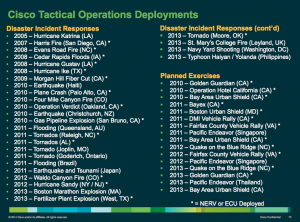
CEO John Chambers has been successfully reinventing Cisco Systems for 19 years, but his best innovation has a very low profile. In fact, this is the first time I’ve heard/read about it in the nine years it’s been around.
The unsung innovation is called TacOps and it’s actually a team of heroes.
TacOps is a combination of people and equipment that bring emergency communications to areas devastated by both natural and manmade disasters.
Cisco has a special team called Tactical Operations that swoops in after natural disasters to get Internet and telephone service back up, so that rescue workers can do their jobs.
TacOps first response was in 2005 for Hurricane Katrina and its most recent to Typhoon Haiyan.
The cost of both equipment and manpower is totally funded by Cisco.
Nor does the team wait until things settle down; rather they are there with the first responders in a crisis when working communications are so critical to saving lives.
And while these deployments may showcase its equipment in a positive way you can be sure that’s not the driving factor.
If it was, we all would have heard a lot more about it over the last nine years.
So hats off to Cisco; it sure would be nice if more companies emulated its efforts in their own way.
Image credit: Cisco TacOps
Posted in Culture, Innovation | 1 Comment »
Wednesday, February 5th, 2014
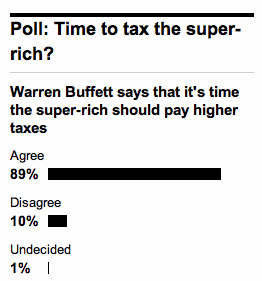
There’s been a social media firestorm since Tom Perkins had his say in defense of the so-called 1%.
I asked a retired serial entrepreneur who was funded by KPCB decades ago when the names on the door were actually working partners what he thought.
Tom was reasonably liberal when he was running KP. Many VC’s who had made tons of dough became very conservative as they aged, supporting right wing Republican and Libertarian causes. They seemed to regard it as an insult that the government was trying to take even a tiny smidgeon of their billions in taxes.
I get why Perkins comments incited so much noise, both sincere and politically correct, but the real story a few days earlier didn’t get the play it deserved.
Here’s the headline that should have gotten more attention.
World’s richest 85 people have as much as bottom half the population
This means the world’s poorest 3,550,000,000 (3.55 billion) people must live on what the richest 85 possess.
The statistics are from non-profit Oxfam and are neither political nor partisan—they just are.
Nor are they an indictment of the US, since they are global.
In line with the mantra of “think globally, act locally” what can you do to help change this?
KG Charles-Harris says,
“It’s really action in the little ways that makes a difference. Not everyone has to do big things, but small things are possible every day with little cost.”
Here are some ideas,
- Choose your role models more carefully; Richard Branson, Bill Gates and, more recently Mark Zukerberg are all in the 85%, but they model their lives very differently from Larry Ellison or the Koch Brothers.
- Commit to giving one week’s worth of what you normally spend on coffee to a cause you care about.
- Do the same with the time you save.
I’ll end by borrowing a line from a 1971 Alka-Seltzer® ad, “Try it, you’ll like it.”
Flickr image credit: playerx
Posted in Change, Culture, Leadership | No Comments »
Friday, January 24th, 2014
A Friday series exploring Startups and the people who make them go. Read all If the Shoe Fits posts here

This is a short post, because I want you to read the longer one at the link.
In an opinion piece, Sam Polk, a former hedge-fund trader and current founder of the nonprofit Groceryships, talks about wealth addiction.
Wealth addiction was described in 1980 by the late sociologist and playwright Philip Slater, but Polk speaks about it from a been there/done that perspective.
I was 30 years old, had no children to raise, no debts to pay, no philanthropic goal in mind. I wanted more money for exactly the same reason an alcoholic needs another drink: I was addicted.
Read the post, then look in the mirror and ask yourself if you are or are getting addicted.
Wealth addiction isn’t a case of wanting to get rich; it is a case of nothing is enough.
And it applies to more than money—from followers to titles to trophy relationships and everything in-between.
Image credit: HikingArtist
Posted in Ethics, If the Shoe Fits, Personal Growth | 1 Comment »
Thursday, January 23rd, 2014
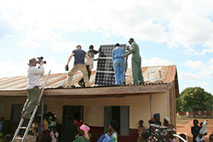
Entrepreneurs who make a difference are my favorite people, whether they do it in for-profit or non-profit mode.
The two I’m highlighting today are both non-profits and both are doing the kind of innovation you’ll want to support.
What do you consider the most basic need for the poor, isolated, rural villages in African nations? If your response is sanitation, clean water, access to healthcare or education you would be one level too high.
All of those mentioned are like apps, but apps that need a common platform to work. So the most basic need; the one that makes the others possible is energy.
And energy is what Sivan Borowich-Ya’ari’s non-profit supplies.
Innovation: Africa, a non-profit that brings Israeli innovation to African villages. In five years, Innovation: Africa has provided electricity, clean water, food and medical care to more than 450,000 people in Ethiopia, Tanzania, Malawi and Uganda.
While solar panels solved the energy-generation problem, the system wasn’t sustainable, because there was no money to replace the needed light bulbs and batteries.
Innovation: Africa solved that by helping create a micro business that generated enough revenue to pay the replacement costs.
People come from the villages surrounding the clinic to charge their cell phones, paying 10 to 15 cents. That money is collected, deposited in a bank and used for two things. One, to buy light bulbs. Second, to replace the batteries. So, we are providing the villagers the solar energy and also a way to generate income so that they can sustain it.
Sound interesting? Why not put a group together and adopt a project?
The best practice would be to adopt a project; we have at least 38 villages now that are waiting for energy. We know that it’s quite urgent. We would like to do it by 2014. …adopt a specific school or an orphanage, a medical clinic and speak to those children directly and figure out their needs.
D-Rev is a non-profit product development group whose solutions sit atop that energy platform.
Its original focus was to redesign medical devices for poor areas (the first is a phototherapy system that addresses the widespread problem of infant jaundice) and then work with third-party, for-profit distribution companies.
But that didn’t work.
“We thought if you design a good product, it will scale on its own,” Krista Donaldson said. “That works in efficient markets, but most developing communities don’t have efficient markets.” (…) D-Rev has had to become far more involved than it expected in financial models, licensing deals, consulting services and manufacturing arrangements. In essence, it is redesigning not only high-tech products but also supply chains and procurement systems.
I hope you will take a few minutes to read the articles and choose to get involved; if not with one of these then find something that ignites your passion and, as Nike would say, just do it.
Image credit: Innovation: Africa
Posted in Business info | No Comments »
Thursday, January 9th, 2014
Have you noticed that many of the hot startups from young founders are relatively shallow—focused on sharing pictures and facilitating casual hookups.
Facebook was originally a way for college students to connect with each other campus by campus and Twitter was more a digital gossip line than a vehicle for the likes of Arab Spring.
There’s a simple reason for that—people tend to create solutions for the problems they find in their own lives.
It’s not so much how old you are but your experiences and how you see the world that makes for great entrepreneurs—but more are older than younger.
“The average age of a successful entrepreneur in high-growth industries such as computers, health care, and aerospace is 40. Twice as many successful entrepreneurs are over 50 as under 25. The vast majority — 75 percent — have more than six years of industry experience and half have more than 10 years when they create their startup,” says Duke University scholar Vivek Wadhwa, who studied 549 successful technology ventures. Meanwhile, data from the Kauffman Foundation indicates the highest rate of entrepreneurship in America has shifted to the 55-64 age group, with people over 55 almost twice as likely to found successful companies than those between 20 and 34.
These are the people who often tackle enterprise and healthcare challenges, because they have been stymied with them in their own work.
Additionally, the larger the worldview the greater the level of empathy leading to substantially more compassion and a stronger desire to “fix it.”
A good example of this is found in Project Daniel.
Project Daniel started in 2012, when Mick Ebeling read a story in Time magazine about Daniel Omar, a then 14-year-old Sudanese boy who lost both his hands from a bomb. It inspired Ebeling to assemble a team capable of creating a low-cost, 3D-printed prosthetic on consumer-grade 3D printers.
Ebeling is the founder of Not Impossible, a company dedicated to “technology for the sake of humanity” which also developed the Eyewriter.
Now you, too, can volunteer with a team, expand your worldview and help change lives, as well as expand your network and have great bragging rights.
YouTube credit: Not Impossible Labs
Posted in Entrepreneurs | No Comments »
Thursday, October 17th, 2013
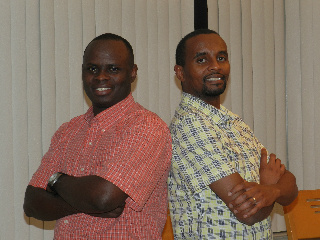 Yesterday was launch day. Finally! Long time coming. Yesterday was launch day. Finally! Long time coming.
Let me explain.
A couple of years ago Tony Maina got in touch regarding his startup ZOOMPesa.
Tony and his co-founder Jesse Gitonga Mukundi have a strong belief in “doing good by doing well” as do I.
One conversation led to another and the short version is that I became deeply involved in crafting ZOOMPesa’s social aspect and other parts of their branding, which included developing the content for our crowdfunding campaign on indiegogo.com. (indiegogo was chosen because, while Tony and Jesse are Kenyan, they live in Canada.)
Along with being an active participant, I was also invited to serve on the formal advisory board.
Rather than paraphrasing, here is a brief excerpt from the campaign to explain ZOOMPesa.
ZOOMPesa was born of our frustration when sending money home to our families Kenya.
Frustration because the wiring companies charged so much that there was less for our families and because it was so inconvenient for everybody.
So we put our heads together and figured out the kind of service we wanted.
- An ultra-convenient service that allowed international money transfers using any kind of dumb or smart mobile phone or a computer online that was instantly credited to a mobile money account, AND
- charge 20-50% less than other services depending on the amount of money sent AND
- let that one low fee cover transfers to 2 or even 3 different people.
Then we started thinking about how Tom’s Shoes and Warby Parker give a pair of shoes or glasses for every one that’s bought and we wanted to do something like that, too.
Giving our service free didn’t make sense, but giving a percentage of each fee to a group, like a clinic or school, that’s local to the sender did make sense. And with your help that’s exactly what we’re going to do.
ZOOMPesa will make sending money home convenient and inexpensive and let us all GIVE BACK at the same time.
That’s why we call ZOOMPesa the money transfer service with a heart.
Please visit our campaign to learn more.
And donate because an affordable money transfer service is badly needed as is the social good that comes with its use; plus we have some cool rewards.
On a personal level I want ZOOMPesa to succeed for many reasons, not the least of which is proving that a financial services company can be profitable and succeed without sky high fees and lousy customer service.
(Contact me for help with your crowdfunding content.)
Image credit: ZOOMPesa
Posted in Entrepreneurs, Innovation | 1 Comment »
Thursday, October 3rd, 2013
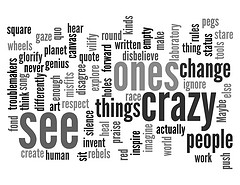
Welcome to Unreasonable at Sea, a four-month-voyage that aimed to combine the shipboard campus of Semester at Sea with the entrepreneurial zeal of globalized markets and the do-gooder communal spirit of a hackathon. (Read the article here)
The event, while interesting, isn’t what caught my eye; what did hit me was this remark from an attendee.
Wade Colburn, a college junior from California majoring in biomedical engineering, wasn’t one of them, but he joined this Semester at Sea program mainly because of Unreasonable. “You can do something that’s for, like, the better of the world and still make a profit,” he said. “That was a huge shift in my thinking.”
How sad is that?
Think about it; roughly 20 years old with a medically oriented major and a mindset that was completely focused on profit.
It makes you wonder how he was raised and what values he brings to the table.
One can only hope that the “huge shift in thinking” is permanent and that he shares it with his friends.
What’s your thinking?
Does it also need to shift?
Flickr image credit: Ian Aberle
Posted in Entrepreneurs | No Comments »
Wednesday, October 2nd, 2013
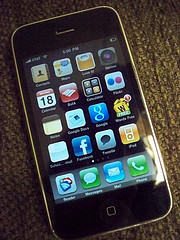
For many LIFE has become life, which they choose to live out on a small screen instead of on nature’s infinite stage.
But for some, that small, smooth screen is becoming an onramp to the infinite stage.
Smartphones and tablets, with their flat glass touch screens and nary a texture anywhere, may not seem like the best technological innovation for people who cannot see. But advocates for the blind say the devices could be the biggest assistive aid to come along since Braille was invented in the 1820s.
Not surprisingly, the iPhone is a leader in assistive apps.
One such is VoiceOver, which reads aloud the name of each app as you run your finger over it, just as a visual label shows when you rollover a menu item.
Many developers either don’t think or can’t be bothered to take advantage of the technology by labeling the buttons on their app, which leaves sight-challenged users literally in the dark.
What those developers haven’t figured out is that this is a substantial market—ten million in the US alone and a globally aging population that guarantees it will grow.
Moreover, it’s a highly networked market where anything new and useful is speedily shared.
Even if you are strictly in it for the money enabling your app to take advantage of the assistive technologies built into iOS and Android is smart, since doing so can differentiate you from the pack and help you access valuable media attention.
Writing an app seems to be a right of passage these days even among non-techies for whom it is a hobby and not a job.
So why not write it for a built-in, accessible market and do a bit of good along with the added income?
Flickr image credit: Bonnie Brown
Posted in Entrepreneurs, Innovation | No Comments »
|
 Subscribe to
Subscribe to
MAPping Company Success
About Miki 
Clarify your exec summary, website, etc.
Have a quick question or just want to chat? Feel free to write or call me at 360.335.8054
The 12 Ingredients of a Fillable Req
CheatSheet for InterviewERS
CheatSheet for InterviewEEs™
Give your mind a rest. Here are 4 quick ways to get rid of kinks, break a logjam or juice your creativity!
Creative mousing
Bubblewrap!
Animal innovation
Brain teaser
The latest disaster is here at home; donate to the East Coast recovery efforts now!
Text REDCROSS to 90999 to make a $10 donation or call 00.733.2767. $10 really really does make a difference and you'll never miss it.
And always donate what you can whenever you can
The following accept cash and in-kind donations: Doctors Without Borders, UNICEF, Red Cross, World Food Program, Save the Children
*/
?>About Miki
About KG
Clarify your exec summary, website, marketing collateral, etc.
Have a question or just want to chat @ no cost? Feel free to write
Download useful assistance now.
Entrepreneurs face difficulties that are hard for most people to imagine, let alone understand. You can find anonymous help and connections that do understand at 7 cups of tea.
Crises never end.
$10 really does make a difference and you’ll never miss it,
while $10 a month has exponential power.
Always donate what you can whenever you can.
The following accept cash and in-kind donations:
|
![]()








 Yesterday was launch day. Finally! Long time coming.
Yesterday was launch day. Finally! Long time coming.


